I met with Peter Brown Hoffmeister in his element, on an overcast summer Monday at the Columns, the basalt rock climbing area of Skinner Butte Park in Eugene, Oregon. You can find Hoffmeister there upwards of one hundred days a year, either with his family or the students he teaches in the Integrated Outdoor Program at South Eugene High School. Hoffmeister has a lot of energy. Besides raising two daughters, running the program, and guiding outdoor adventures, he has published three books in three different genres over the course of three years.
Hoffmeister’s debut novel, Graphic the Valley, is every bit as ambitious as its author. Set entirely in Yosemite Valley, the book is a modern day retelling of Samson and Delilah. Hoffmeister goes big, weaving history with myth and pitting one young man against overwhelming obstacles, both manmade and natural. While the term “Biblical proportions” is justified here, Hoffmeister never loses sight of the human heart of the story, and he isn’t content to simply plug modern contrivances into an ancient account. This book will challenge readers like Yosemite challenges climbers. While I would have loved to follow Hoffmeister up Half Dome that Monday, I was happy to settle for the top of Skinner Butte, where we talked about his book.
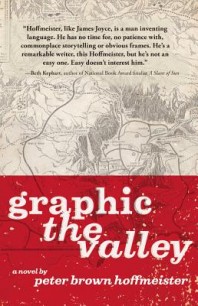
“Hoffmeister’s intimate knowledge of this place, this way of life, pulls you in, ensnares you in the struggle to protect Yosemite from itself.” —Pete Fromm
TC: In the Acknowledgements, you mention that this novel is an extension of a short story you wrote. What was the heart of that story?
PH: I have to thank Miriam Gershow [The Local News] because she read the story and said there was too much there, that I had to expand it. So I started with the story of Tenaya, the main character, who wasn’t even named Tenaya then, fighting a lion because I wanted to rewrite that section of the Samson story.
I’d been spending a lot of time in Yosemite, camped maybe 150 nights in the Valley, and we had a cougar walk right up on us one time, and I thought, “There’s the lion. That’s the Samson lion.” So it started there with that scene, and then I was reading about the history of Yosemite Valley and I came across Dr. Lafayette Bunnell’s book, Discovery of the Yosemite, which you can read for free online, and it was totally different from everything I thought. Basically, the government has revised history, all the Native history of the area. So I thought if I combine the Samson story and this homeless kid and the true history of the Valley, I might have something there.
TC: I’m guessing you have a lot in common with Tenaya, a bundle of energy who rock climbs or runs when he can’t sleep at night or needs to clear his mind.
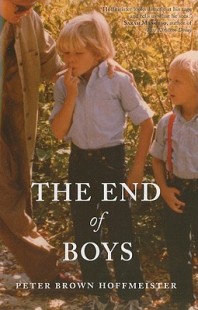 PH: It’s interesting because this book is what I wrote right after my memoir, The End of Boys, and I was trying to write a character that wasn’t me at all. And then I put him in Yosemite Valley, a place I know and love, and then I make him a rock climber. But I did go back over and over and think about this character as a young Samson, and in the ways that he is like Samson, he’s not like me at all. But I do have a lot in common with him. I have slept illegally in Yosemite Valley, scrounged food and finished tourist leftovers and slowly finished jars of peanut butter over a month. Like Tenaya, there are also ways I’m not quite living in my current time period. I don’t have a cell phone and I’m not on Facebook.
PH: It’s interesting because this book is what I wrote right after my memoir, The End of Boys, and I was trying to write a character that wasn’t me at all. And then I put him in Yosemite Valley, a place I know and love, and then I make him a rock climber. But I did go back over and over and think about this character as a young Samson, and in the ways that he is like Samson, he’s not like me at all. But I do have a lot in common with him. I have slept illegally in Yosemite Valley, scrounged food and finished tourist leftovers and slowly finished jars of peanut butter over a month. Like Tenaya, there are also ways I’m not quite living in my current time period. I don’t have a cell phone and I’m not on Facebook.
TC: Not being Native American, did you have any qualms about writing about such intense Native American themes, from the point of view of a Native American?
PH: I thought about that. It’s kind of a strange acquisition to be writing this Native American character, but then, it’s a strange acquisition to be writing any fictional character.
Originally, the novel wasn’t going to have anything to do with Native Americans, just the Samson story. I was going to have his family be there as one of the Depression families. In the 1930’s you could drive in and pay a dollar and live in Yosemite for a year eating fish from the rivers. But I kept reading accounts like Dr. Bunnell’s and those of the Northern Paiutes, and then I was in Yosemite seeing all this misinformation on signs, in the museum, in the Ahwahnee Hotel, and I realized I had to tell this.
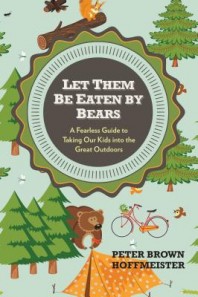 TC: Within minutes of my first and only trip to Yosemite Valley about eight years ago, I watched a rented RV plow into the back of an automobile. In your nonfiction manifesto, Let Them Be Eaten By Bears: A Fearless Guide to Taking Our Kids Into the Great Outdoors, you lament that the use of America’s parks and forests has steadily declined in recent years, while in Graphic the Valley, the danger is the over-commercialization of Yosemite. How do you reconcile this need to get more people out there with the dangers of getting too many people out there?
TC: Within minutes of my first and only trip to Yosemite Valley about eight years ago, I watched a rented RV plow into the back of an automobile. In your nonfiction manifesto, Let Them Be Eaten By Bears: A Fearless Guide to Taking Our Kids Into the Great Outdoors, you lament that the use of America’s parks and forests has steadily declined in recent years, while in Graphic the Valley, the danger is the over-commercialization of Yosemite. How do you reconcile this need to get more people out there with the dangers of getting too many people out there?
PH: That’s a tough one, and that was weird with these books coming out eight weeks apart. I guess the big thing is whether it’s motorized technological tourism, because if it is, that’s not a valuable way to spend your time visiting a national park. I was reading statistics and there was one year when 98% of the Valley visitors drove in, drove the Valley loop, and drove out without hiking, swimming, fishing, climbing, camping, or doing anything away from their vehicles. If that’s how you’re visiting a national park, just getting your car pass stamped like Edward Abbey says in Desert Solitaire, just being part of the endless line of tourists rushing from park to park, then I’m not encouraging that. But of course, I’m not even saying you need to go to a national park in Let Them be Eaten By Bears. It’s just as valuable to me to climb this butte or go into your backyard and catch bugs with your kids.
TC: Just about the only genre you haven’t published a book in is poetry, but your fiction definitely uses a lot of imagery.
PH: Well, I studied poetry first, and I still read and admire poets, so I really think about imagery and try to write it in an original way. For this book, I was thinking of the Valley and the world as black and white photographs, thinking about every item as black and white because the contrast is so good. What elements would be brought out if it were a black and white picture? Everything I wrote I tried to picture as a black and white image. There’s something symbolic there, but I mean it literally. What would stand out in a black and white image of this bear or this cougar or this trail or this boulder?
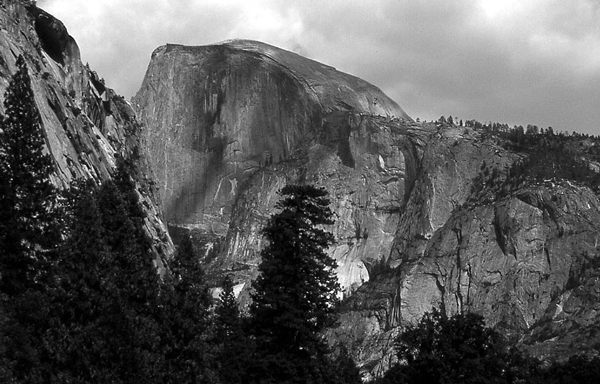
Half Dome, photo by Tom Cantwell
TC: I was intrigued by how most of the present action in Graphic the Valley is written in past tense, while most of the past action is written in present tense.
PH: I was thinking that our childhoods and our pasts and our families are always with us, always present with us, whereas our present actions and in-the-moment choices fade quickly. I mean, there are some consequential choices, but what we’re doing right now will quickly go away. But how we were raised, and our family histories, and what we learned as children are with us forever. So I put that in present tense and the current action fades to past immediately.
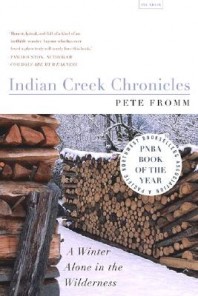 TC: Indian Creek Chronicles has been on my list of books to read for too long, but I have to ask; was author Pete Fromm included in Graphic the Valley before he wrote the blurb that appears on the back cover?
TC: Indian Creek Chronicles has been on my list of books to read for too long, but I have to ask; was author Pete Fromm included in Graphic the Valley before he wrote the blurb that appears on the back cover?
PH: I originally had Tenaya read Hemingway’s For Whom the Bell Tolls and name the coyote Robert Jordan. Then, when I was sending the last draft to my editor, I started thinking that Tenaya might not like For Whom the Bell Tolls. I wondered what book he might read while wintering over and I came up with Pete Fromm’s Indian Creek Chronicles: A Winter Alone in the Wilderness. So I changed it for that draft, changed the coyote’s name to Pete Fromm and sent it to my editor. Then my publisher calls, hasn’t even read the new draft, doesn’t know Pete Fromm’s in the book, and says, “I’ve been researching Northwest writers and I really think we should try to get a blurb from Pete Fromm.” So I thought that was kind of funny, but I honestly didn’t think Pete Fromm would give us a blurb. But then he did, and he sent me an e-mail saying, “I didn’t really know what to think when suddenly I was a coyote, because I’ve never been in a book, and I’ve never been a coyote.”
Tom Cantwell lives in Eugene and teaches in the same school district as Hoffmeister. He probably doesn’t have as much energy as Hoffmeister, but he does have two children who keep him quite busy. He is an MFA candidate in the low-residency Rainier Writing Workshop at Pacific Lutheran University, and his fiction has appeared in Whitefish Review.
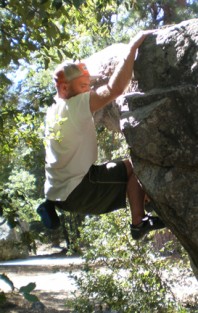


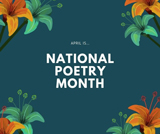
[…] Pacific Northwest Booksellers Association ran this interview today (A Lion Walks Into Camp), including a Miriam Gershow credit, a Pete Fromm Coyote happening, and my attempts at writing […]